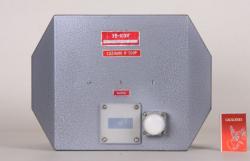- U-I-R-Messtechnik
- Signalgeneratoren
- Frequenzmesser
- Oszilloskope
- Analyzer & Wobbler
- Leistungsmesstechnik
- R-L-C-Messtechnik
- Prüftechnik, Spezialmesstechnik
- Energieversorgung
- Funktechnik
- Radar & GHz
- NF & HiFi
- Licht & Optik
- Steuer- & Regelungstechnik
- Telefonie & Kommunikation
- Mechanik
- Avionik
- Sammeln & Seltenes
- Bauelemente
- ...
- Röhrenliste
- Manuals & Schaltpläne
- sonstiges...
Informationen
Wanderfeldröhre UV-1031G
Art.Nr.: roe-wan-0010a
Hochfrequenz- Leistungsverstärker UV-1031G, russische Bezeichnung УВ-1031Г.
Technical datas below.
Wanderfeldröhre UV-1031G, УВ-1031Г
* Hochfrequenz- LeistungsverstärkerWanderfeldröhre UV-1031G, УВ-1031Г, TWT UW1031G, Travelling Wave Tube УВ-1031Г




Technische Daten Wanderfeldröhre UV-1031G :
TRAVELING - WAVE - TUBE UV-1031 G
PRINCIPAL TECHNICAL DATA
| Denomination of parameter, measurement unit | Significances of parameters | ||
| allowable operating | actual | ||
| minimal | maximum | ||
| 1. First anode voltage,V | nom-1% | nom+1% | |
| 2. Second anode voltage,V | nom-1% | nom+1% | |
| 3. Third anode voltage,V | nom-1% | nom+1% | |
| 4. Fourth anode voltage,V | nom-1% | nom+1% | |
| 5. Fifth anode voltage,V | nom-1% | nom+1% | |
| 6. Sixth anode voltage,V | nom-1% | nom+1% | |
| 7. Seventh anode voltage,V | nom-1% | nom+1% | |
| 8. Eighth anode voltage,V | nom-1% | nom+1% | |
| 9. Slow-wave structure voltage, V | 100-1% | 270+1% | |
| 10. Collector voltage, V | 400-5% | 400+5% | |
| 11. Filament current, A | nom-1% | nom+1% | |
| 12. Slow-wave structure current, µA | – | 75 | |
| 13. Collector current, µA | – | 150 | |
| 14. Operating wavelength range, cm | 4.37-4.65 | – | 4.37-4.65 |
| 15. Noise factor, unit | – | 4 | |
| 16. Power gain, dB | 20 | 30 | |
| 17. Gain flatness in the band 5%, dB | – | 3 | |
| 18. Total starting time, min | – | 2 | |
| 19. Minimum operating time, h | 1000 | – | |
| 20. Ambient temperature, °C | -60 | +85 | |
Notes:
- Instability of power supplies of voltages and the filament current must not exceed the significances indicated in the present table.
- Nom-nominal significance of a parameter indicated in the column "Significances of parameters actual".
- The filament voltage covers 1.7-2.3V.
- The stabilization of the filament voltage is allowed in the filament power supply (instability of the filament voltage is not worse than indicated for the filament current).
ELECTRODES-TO-LEADS CONNECTION DIAGRAM
 |
Designation of leads | Denomination of electrodes and other elements of diagram |
| 1 | Eighth anode | |
| 2 | Cathode, heater | |
| 3 | Heater | |
| 4 | Seventh anode | |
| 5, 10, 11, 14, 15, 17, 19 |
Free | |
| 6 | Second anode | |
| 7 | Third anode | |
| 8 | Sixth anode | |
| 9 | Fifth anode | |
| 12 | Fourth anode | |
| 13 | First anode | |
| 16 | Ninth anode, slow-wave structure, case | |
| 18 | Collector | |
| I | Input | |
| II | Output |
OPERATION INSTRUCTIONS
All voltage are given in respect to the
cathode.
During original installation the TWT, the voltages of anodes and the
filament current should be set equal to the nominal values, indicated
in the column " Significances of parameters actual" of the section I of
the present certificate. The slow-wave structure voltage is set in the
limits indicated in the column " Significances of parameters allowable
operating" for the minimum noise factor or maximum value of the power
gain.
The nominal electrical behaviour is chosen by the producer for the
given TWT in the following limits:
| collector voltage of | 400 V; |
| filament current of | 0.2 to 0.26 V; |
| first anode voltage of | 0 to 10 V; |
| second anode voltage of | 0 to 5 V; |
| third anode voltage of | 2 to 30 V; |
| fourth anode voltage of | 5 to 100 V; |
| fifth anode voltage of | 5 to 100 V; |
| sixth anode voltage of | 50 to 400 V; |
| seventh anode voltage of | 100 to 400 V; |
| eighth anode voltage of | 100 to 400 V; |
| slow-wave structure voltage of | 100 to 270 V; |
During installation of the TWT in
apparatus and in the operating process in every 200 h of an operation,
in order to get the minimum value of the noise factor at allowable
values of the power gain and total starting time in case of need it is
permitted to change the electrode voltages in the indicated ranges and
the filament current in the limits nom +4%/-2%.
The TWT has the natural cooling.
It is permitted the arbitrary position of ferromagnetic materials at
the distance more than 50 mm from the TWT.
It is permitted to locate the ferromagnetic materials at the distance
not less than 10 mm from the TWT when one of axes symmetry coincides
and two rest axes are parallel.
It is permitted the relative position of the TWTs at the distance not
less than 100 mm when fixing the TWT in one plane and also when fixing
the TWT in different planes, at that one of axes of the TWT must
coincide with the corresponding axis of another TWT and two others are
parallel in pairs.
SWITCH ON PROCEDURE
Without connecting the supply connector to the TWT, switch on
the power supply and set the voltages of anodes, slow-wave structure,
collector to the nominal values and the filament voltage equals to 2 V.
Switch off the power supply.
Connect the power supply to the TWT.
Switch on the filament voltage, adjust the filament current to the
nominal value.
In 1 min after switching on of the filament voltage switch on the
voltages of the rest of electrodes (simultaneously).
Notes:
- By repeated switching on of the adjusted TWT the adjustment of voltages is not required as a rule.
- It is permitted to switch on supplying voltages at their earlier set values simultaneously.
SWITCH OFF PROCEDURE
Switch off the voltages of anodes, the slow-wave structure and
the collector simultaneously.
Switch off the filament voltage.
Note: It is permitted to switch off all supplying voltages simultaneously.
It is not permitted to switch off the filament voltage when the high voltages are switched on.
Allgemeines zur Wanderfeldröhre:
Die Wanderfeldröhre gehört zu den Laufzeitröhren.
Eine Laufzeitröhre ist eine Elektronenröhren zur Erzeugung oder -Verstärkung von Mikrowellen. Laufzeitröhren finden also ihre Anwendung in der Hochfrequenztechnik.
Bei den Laufzeitröhren sind die Entladungssyteme so konstruiert, daß Laufzeiteffekte das Funktionieren der Röhre bewirken.
Zunächst wird eine homogene Elektronenströmung konstanter Geschwindigkeit erzeugt, deren Elektronen dann einem steuernden elektrischen HF-Feld ausgesetzt werden, in dem sie je nach Startphase beschleunigt oder verzögert werden.
Bei den Langzeitröhren unterscheidet man zwischen Triftröhren und Lauffeldröhren.
In der Praxis verwendete Laufzeitröhren sind Zweikammer- und Mehrkammerklystrons, Wanderfeldröhren, Rückwärtswellenröhren und Magnetrons sowie gewisse Hybridformen wie Wanderfeldklystrons.
Die Wanderfeldröhre dient der Verstärkung elektrischer Signale. Der Elektronenstrahl wird durch ein nicht mitgezeichnetes homogenes axiales Magnetfeld, herrührend von einem auf möglichst gewicht- und raumsparende Weise gestalteten Elektro- oder Permanentmagneten, oder auch von einem periodischen Permanentfeld, fokussiert und zum Elektronenauffänger geführt. Die zu verstärkende HF-Leistung wird katodenseitig auf die Wendelleitung gekoppelt, wohingegen die verstärkte HF-Leistung kollektorseitig ausgekoppelt wird.
Wanderfeldröhren werden wegen ihrer guten Linearität (Breitbandeigenschaften) und Rauscharmut und wegen des großen Leistungsspielraumes mannigfaltig eingesetzt, z.B. in Bodenstationen für Satellitenfunk mit Dauerstrichleistungen im kW-Bereich, als Satellitenröhren (bis herab zu 20 W interessant; 650g Masse) und für Richtfunktechnik (2700 Kanäle bei 6 ... 7 GHz) sowie für die Radar-Impulstechnik mit Impulsleistungen bis zu mehreren MW. Die Wanderfeldröhre ist ein weit verbreitetes Bauteil in der Radartechnik.
Der Frequenzbereich der Verstärkung ist kleiner als 0,05 dB x MHz hoch -1 im ganzen Bereich, bei optimaler Frequenz sogar noch eine Zehnerpotenz geringer.
Die Zuverlässigkeit der Wanderfeldröhren ist groß, die Lebensdauer dieser Laufzeitröhren liegt bei Größenordnungen von 20 000 Stunden.









